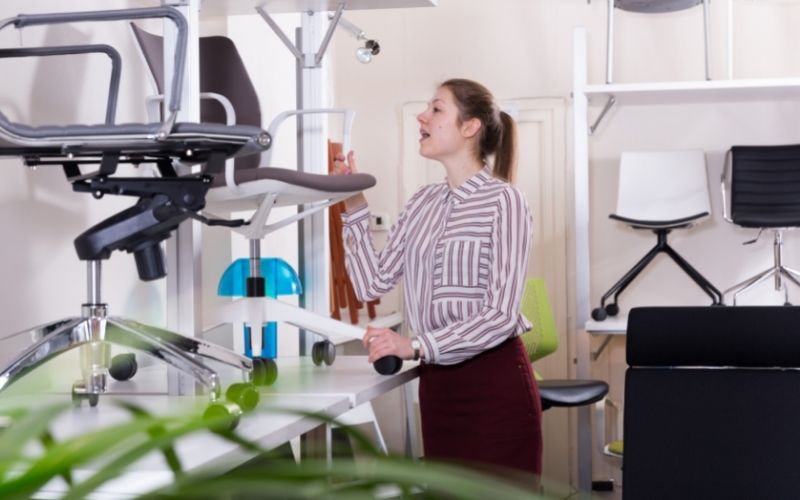Do a 360 around your office.
A few items that reduce workplace efficiency will catch your eye. Is it your laggy computer or the printer that always gets jammed?
When office equipment or furniture affects productivity, it might be time to replace them.
But when do you know that it’s time to replace your office chair?
From physically damaged chair parts to body pains, deteriorating health and posture, and decreased productivity.
Several signs tell you it’s time to retire your office chair.
To help you out, read the top 10 signs of a bad office chair.
Table of Contents
- Signs of a Bad Office Chair
- 1. Physical damage to the chair or parts
- 2. Flattened seat cushion
- 3. Squeaks and creaks
- 4. Bad sitting posture
- 5. Improperly fitted office chair
- 6. Uncomfortable and doesn’t feel right
- 7. No lumbar support
- 8. Swelling and inflammation in the joints and tendons
- 9. Constant aches and pains
- 10. Overstayed its welcome
- How often should you replace your office chair?
- What happens when I sit in a bad office chair?
- Conclusion
Signs of a Bad Office Chair
1. Physical damage to the chair or parts
The most obvious sign that you should replace your office chair is if there are rips and cracks in your office chair.
A chair close to falling apart is obvious, but when do you replace a chair with minor damage?
Here’s what you should look for:
- Stuck or loose casters. Is it getting difficult to push or roll your office chair? If your office chair isn’t as responsive as before, it might be time to upgrade your casters. Consider getting flexible polyurethane casters or premium gliders .
- When essential adjustments like seat height and backrest support aren’t working, consider upgrading to a full chair to achieve the optimal sitting posture. If you can’t adjust seat height, you may need to replace the chair cylinder .
2. Flattened seat cushion
You might notice your sit bones hurting more over time. This might be because your seat pan doesn’t provide enough cushioning anymore.
Seat cushioning is essential to prevent body pains as it supports your body weight. Flattened and compressed cushions put stress on your lower back and back muscles.
Consider upgrading to a new office chair! However, if it’s out of your budget, you can go for ergonomic seat cushions specially designed for sciatica and tailbone relief.
3. Squeaks and creaks
Does your office chair make annoying squeaks and creaks every time you move?
Whether standing up, leaning back on your chair, or making a slight turn, incessant noises from your chair can be embarrassing, not to mention dangerous!
It’s a sign that there are already points of weakness in the chair and that it is for repairs or replacement.
Here’s what you should do:
- Check the source of squeaking and creaking.
- Secure bolts and screws.
- Lubricate rusty bolts.
- Fix the chair springs.
- Apply wood swelling liquid due to loosened legs.
- Apply wood glue to weak points.
While you can make these repairs, try to see if your squeaking chair may be a safety hazard. In this case, it’ll be better for you to replace the chair.
4. Bad sitting posture
The most important ergonomic feature of office chairs is achieving the right sitting posture that supports your back throughout a long day of sitting at a desk.
If your office chair doesn’t have lower back support and a firm seat that supports the base of your spine, you’ll most likely find yourself slumped over.
A good office chair will help you achieve good posture naturally with:
- Your feet on the floor
- A small gap between your knees and the seat
- Your middle and lower back are supported
If your office chair fails to tick any of these, it might be time to find a new chair.
5. Improperly fitted office chair

There’s a possibility that your office chair was never suitable for you in the first place. This is likely the case if you work in a fully furnished office.
Some chairs have fixed armrests that may be too wide or too narrow for you. Maybe the backrest was made for someone shorter or taller than you.
If you are spending at least 40 hours a week in your office chair, you’ll want to look for one that’s suited for your individual needs.
6. Uncomfortable and doesn’t feel right
Sometimes, it all boils down to the fact that your chair isn’t comfortable anymore. No matter how many adjustments you make, if your office chair still doesn’t feel right, it might be time to replace it.
The design or frame might not be ideal for the type of work you do, your body type, or it might not suit your workplace environment.
A chair that’s perfectly ergonomic for you will feel comfortable even after long hours of sitting.
In the end, you should listen to your body.
7. No lumbar support

An essential feature to achieving optimal sitting posture is lumbar support. Lumbar support is placed on the small of your back, helping the lower spine to reach its natural curve.
If your chair doesn’t provide sufficient lumbar support, you’ll likely strain your lower back and back muscles.
Some office chairs don’t provide lumbar support, so it’ll be a good idea to replace your office chair.
If you don’t have the budget to get an upgrade to a new office chair, you can opt for these alternatives:
-
Lumbar support cushion with mesh or memory foam
-
Lumbar support and backrest cushion
-
A small pillow or rolled towel
8. Swelling and inflammation in the joints and tendons
It’s not just your back, neck, and shoulders that suffer after sitting in a bad office chair.
Many people experience stiffness in the joints, particularly the knees, after sitting for long periods. This is mainly due to fluid build-up and inflammation in the joints, causing swelling that makes it difficult to move.
Because of decreased motion in bad office chairs, you must find one that’s easy on your joints, especially if you have arthritis.
Many people also experience pain in the hips due to bad posture. This can lead to inflammation of the tendons or tendonitis.
9. Constant aches and pains
Let’s get one fact straight: constant aches and pains aren’t normal even after a long day’s work! Persistent discomfort in the office will eventually become distracting, and it can negatively affect your energy and productivity.
The most common spots with pain and discomfort after sitting are:
- Neck
- Upper or lower back
- Shoulders
However, it’s also likely to cause sharp stabbing pains, burning sensations, or maybe even numbness in the fingers, hands, and wrists
Replacing your office chair with a more ergonomic one will remove your everyday aches and pains, leading to a healthier body and a more productive mindset.
When left uncorrected, your minor aches and pains can lead to more severe cases of tendonitis, osteoarthritis, sciatica, bursitis, and pinched nerves.
10. Overstayed its welcome
All good things come to an end, even the best office chair.
Replacing your chair every few years will ensure that you have the proper support and cushioning. You’ll also reduce the risk of slumping or experiencing aches and pain.
How often should you replace your office chair?

An office chair can last anywhere between a single year to a decade.
Standard office chairs should be replaced every five years, but a good quality chair can last between seven and ten years.
Spending a little more on your office chair upfront will likely land you a quality product, ensuring that it lasts longer than a few years.
What happens when I sit in a bad office chair?
Sitting in a bad office chair, or even one that’s not adjusted properly can result in multiple posture and health-related issues.
Here are five consequences of sitting in a bad office chair:
Back, shoulder, and neck pain

Sitting for long hours will keep your spine inflexible, and pain will often spread to your lower back, shoulders, neck, and hips.
Poor sitting posture can lead to compression of discs, chronic pain, and premature spine degeneration.
Increased body fat and weight gain
Sitting in a chair that limits movement will eventually lead to weight gain due to a lack of the lipoprotein lipase molecule that processes fats and sugars.
Poor brain health: increased fatigue and lack of concentration

Did you know that poor posture can lead to poor brain health as well? That’s right, whenever your spine isn’t properly aligned, the other parts of your body work together to compensate for stability. This increases fatigue and causes “brain fog.”
The muscular movement will help bring blood and oxygen to the brain, increasing focus and productivity.
Poor blood circulation
A chair that’s not adjusted correctly to your body will lead to poor blood circulation to your legs, arms, shoulders, back, and neck.
According to a study, extended hours of sitting with poor blood circulation can lead to heart disease or stroke, quite similar to the effects of smoking.
Digestive issues

The wrong office chair can also lead to indigestion, eventually leading to poorer health and malnutrition.
Bad sitting posture puts unnecessary pressure on your abdomen and stomach. This can eventually lead to problems with bloating, bowel movement (constipation), acid reflux, malnutrition, and even heartburn.
Conclusion
You might not realize it, but your ergonomic office chair might not be so ergonomic anymore. A task chair is arguably the key to achieving office ergonomics, and sticking with a chair that’s well past its prime will reduce your workplace efficiency and productivity.
There are many tell-tale signs that it’s time for your office chair to retire.
Bad office chairs lead to body aches and pains due to insufficient support, leading to degenerated health and decreased productivity.
While it’s easy to correct most bad signs of office chairs with accessories or parts replacement, in some cases (such as an ill-fitting chair and creaks that can’t be ignored) it’s most definitely time to get a new office chair.

My name is Vance, and I am the owner of To Ergonomics. Our mission is to improve your workflow by helping you create a supportive and welcoming environment. We hope that you’ll find what you’re looking for while you’re here.

